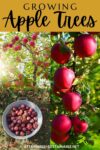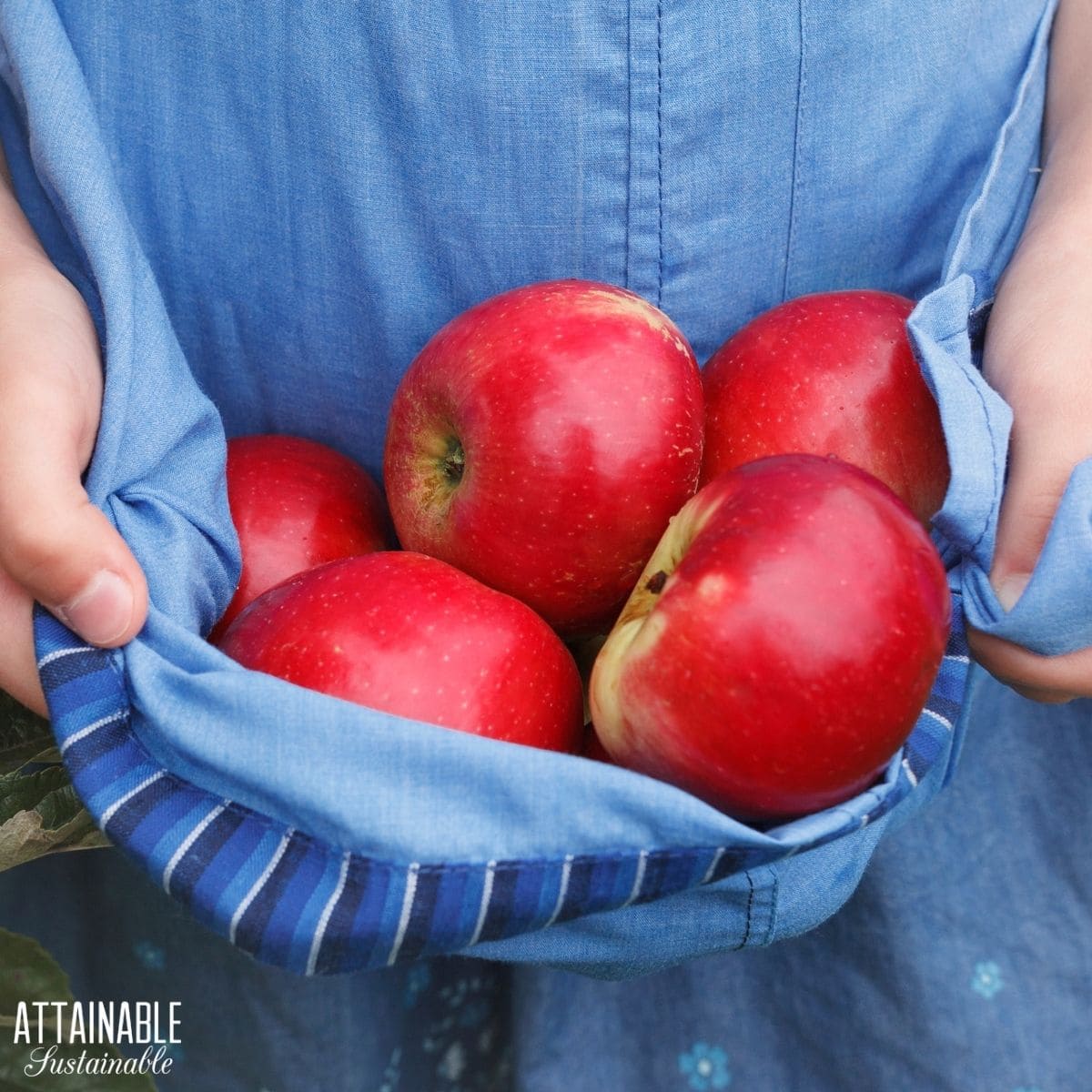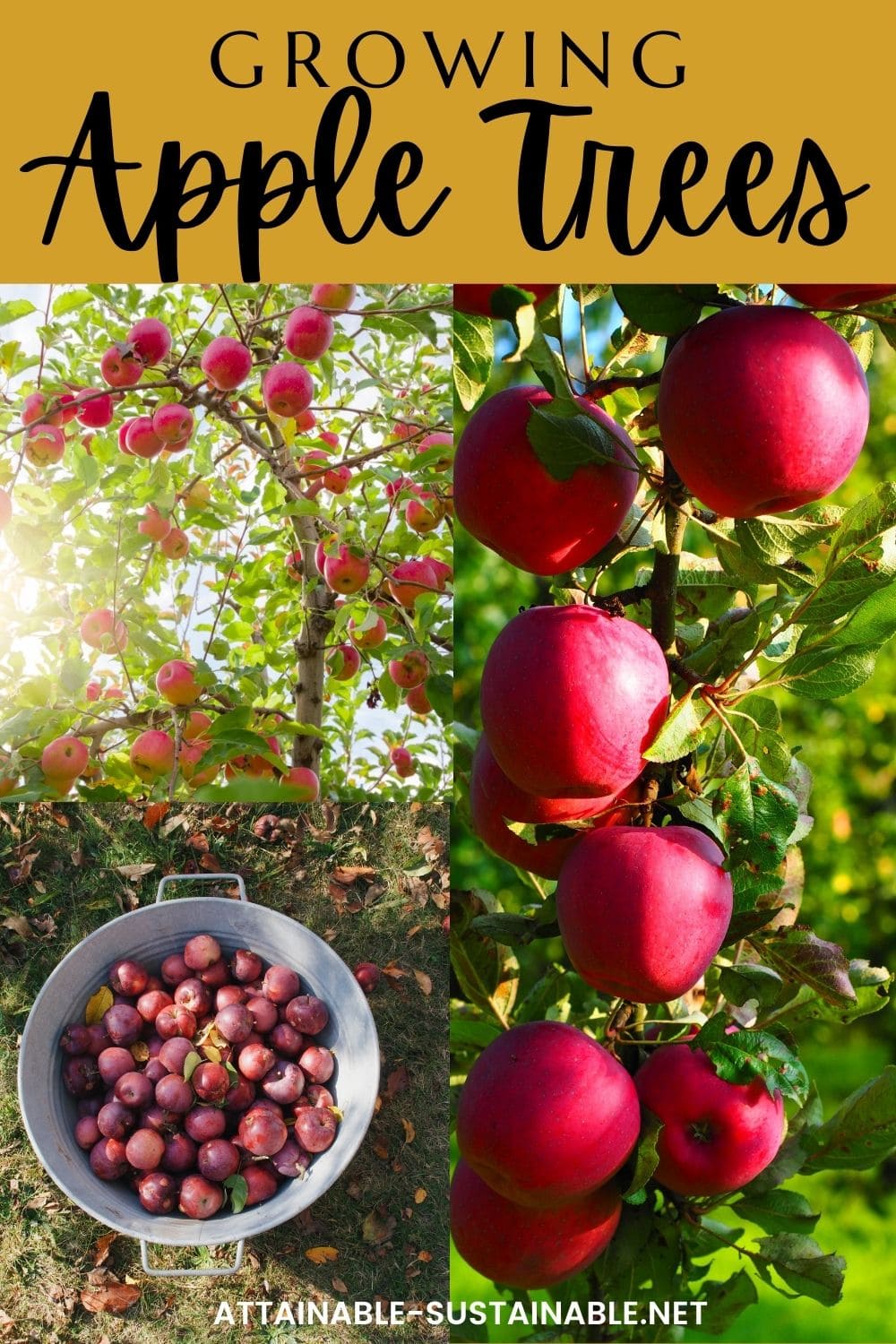Growing apple trees is a perfect way to have tasty snacks picked straight from the tree. Two apple trees are necessary for proper pollination, which is twice as many apples to eat! Use them for fresh eating, canning and preserving, baked goods, and homemade sauces and fruit butter.
Read more about growing fruit trees in an edible landscape here.
Contributed by Jodi Torpey, author and Master Gardener.
The basics of growing apples (Malus pumila)
Apple trees are one of the most popular fruit trees gardeners like to plant and grow. The trees are thought to have originated in southwestern Asia thousands of years ago.
The old gardener’s saying of “right plant, right place” is especially true when it comes to planting and growing apple trees. It’s important to match the apple cultivar, the mature size of the tree, and its cold hardiness to your landscape and growing region. Other considerations are disease resistance, adaptability, and timing for trees to bloom and for apples to ripen.
When it comes to producing apples, trees need two things: pollination and fertilization. Apple trees are referred to as self-unfruitful. That means they need cross-pollination with another apple tree to produce fruit, but not just any apple tree. These two apple trees need to be two different varieties that bloom at the same time. Take time to plan your tree selections.
Grow Some Greens!
Ready to grow fresh greens, no matter WHERE you live? Sign up for my
FREE quick-start guide and start growing some of your own food!
Plant apple trees with the same bloom time within 50 feet of one another to ensure a good fruit set. Make sure there’s room for two trees in your landscape or consider a neighbor’s apple tree to provide for cross-pollination. Planting a crabapple tree is another way to provide good pollination.
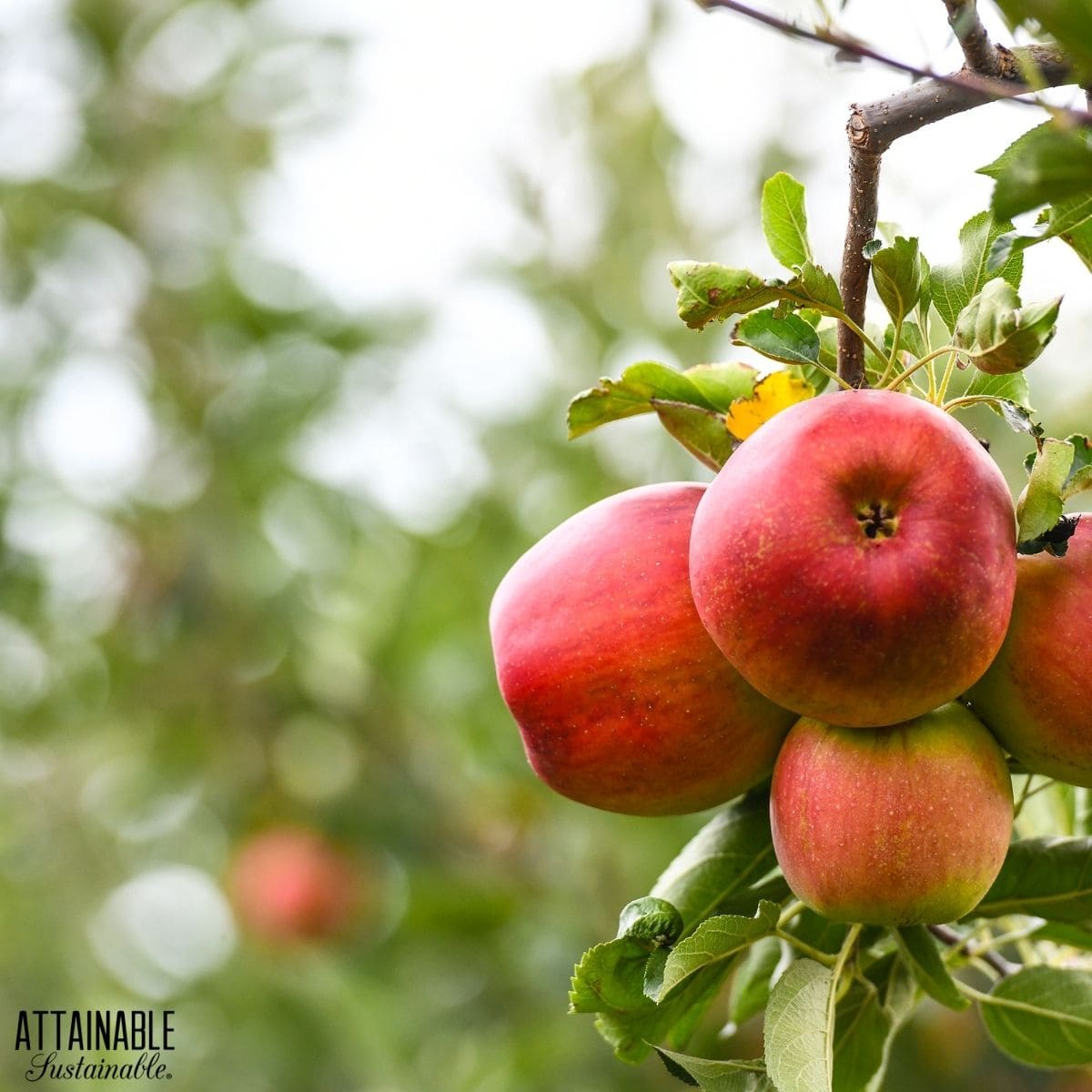
Apple trees can provide fruit from late summer into fall.
Some apple varieties, like Golden Delicious, will produce apples without cross-pollination from a second type of apple tree; however, the yield may not be as big.
For planting, select a sunny planting spot, one that’s away from the house and other buildings. Avoid planting apple trees in the lawn. That’s because it’s challenging for a new tree to have to compete for water, oxygen, and soil nutrients, plus apple trees don’t need as much water or fertilizer as lawns do.
Another key to growing great apples is regular pruning. Apple trees need to be pruned annually so they are wide to allow for sunlight to reach the interior of the tree and enough space for the fruit to grow. Prune when trees are dormant in fall or in spring before buds start to grow. Prune lightly to remove crossing branches, dead branches, or diseased branches.
New to gardening? Limited on space? The 5-Gallon Garden gives you the skills you need to grow food in the space you have. Get started with your garden today!
Apple tree varieties
Consider how much space you have for tree growing and keep your hardiness zone in mind when selecting apple tree varieties. Also remember it can take several years for trees to produce apples and the yield of apples on older trees may also vary from year to year.
You can match the size of trees to your space using these guidelines:
- Dwarf apple trees are meant for small spaces and grow 6 to 10 feet tall.
- Semi-dwarf trees grow to 12-15 feet tall
- Standard trees grow to 20-25 feet tall and wide.
Here are just three varieties available in dwarf, semi-dwarf, and standard sizes:
Honeycrisp apples are a new favorite with pink skin and cream-colored flesh; a juicy and exceptionally crisp apple. Hardiness Zones 4-7.
Royal Court Cortland is an all-purpose apple with red skin and white flesh and good resistance to fire blight. Hardiness Zones 3-8.
Prairie Magic is a hardy variety from Canada with exceptional flavor wrapped in pink skin. Hardiness Zones 3-7.
Anna is a variety that doesn’t require the chill hours that some apples do, making it a good choice for southern gardeners.
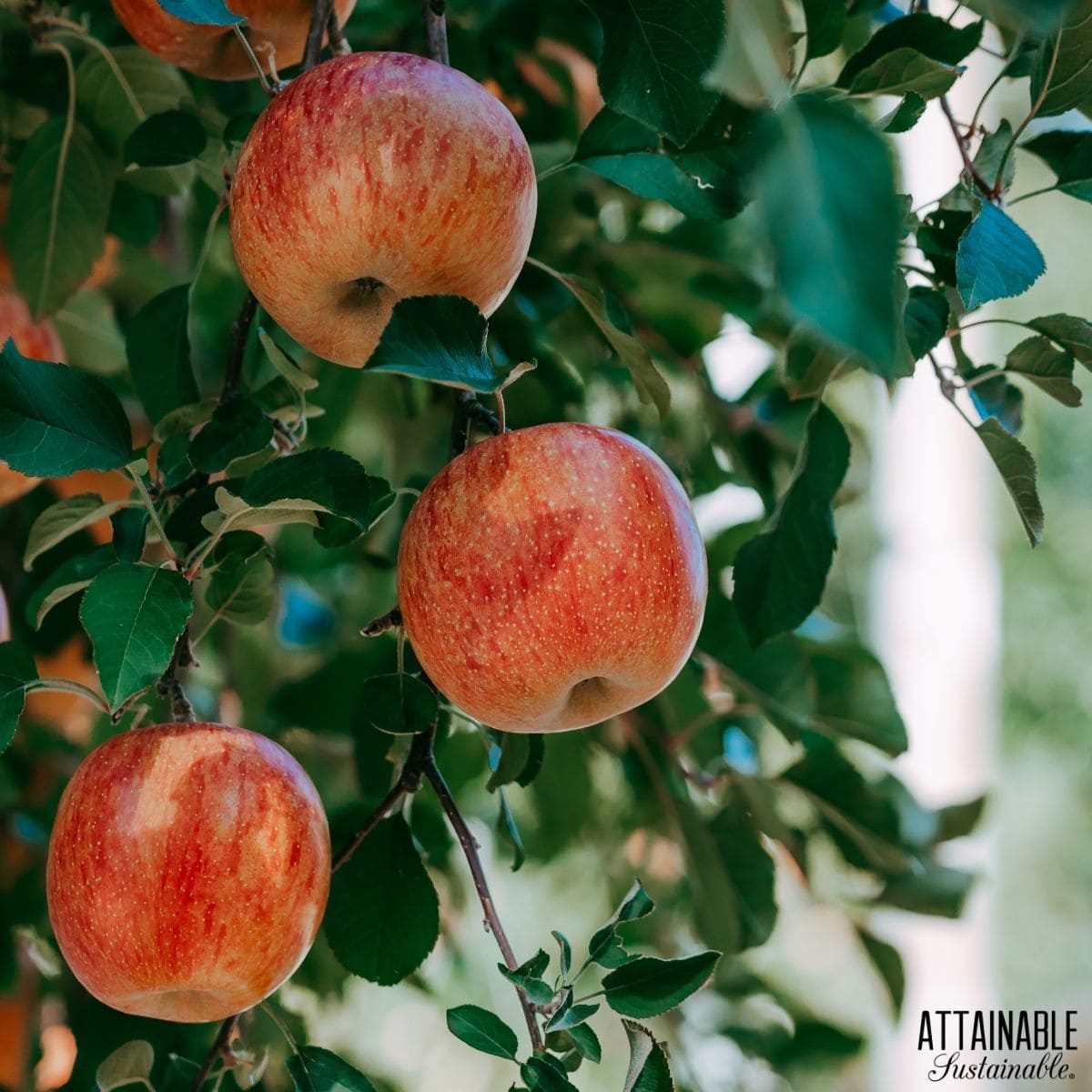
When apples reach maturity, they’re an easy to grab snack!
Requirements for growing apples
Soil requirements
Prepare the soil so it’s well-drained. The best soil for fruit trees is one that allows for good air and water circulation. For sandy or loamy soils, mix about 1/3 compost with 2/3 native soil for good drainage.
Light requirements
Apple trees need full sun — at least 8 hours of sun each day during the growing season, especially when in full bloom. Take time to match the placement of apple trees based on the amount of sunlight they’ll receive when they’ll need it the most.
Fertilizer and water requirements
Apple trees have few fertilizer requirements, but they may need a boost of nitrogen if they aren’t growing or the leaves show signs of being stunted.
Newly planted apple trees should be watered for about an hour once every two weeks, although more water may be needed to keep the root ball from drying out. Water at the soil level, around the drip line.
Be patient and continue to care for trees throughout the year, which may include watering during dry winters. In cold-weather regions, water several times over the winter when the temperatures are above 40 degrees and there is no snow cover. Water early in the day so it soaks in before freezing overnight.
Prevent apple-growing problems
To prevent future problems, give your trees the best start possible. The key to healthy trees is to avoid planting them too deep because that slows root growth.
Tips for planting apple trees
Apple trees are often available as a bare root tree. A bare root plant comes just like it sounds – with its roots bare, rather than planted in a pot full of soil. Bare root fruit trees and shrubs are available during the late winter, when the plant is dormant and has no leaves. During spring or summer months, you’ll be more likely to find potted trees.
Planting bare root apple trees
- Prune any broken or damaged roots.
- Soak the roots in a bucket of water overnight.
- Dig a hole two times the width and depth of the root system you are working with.
- Set the roots on the bottom of the hole so that the graft union is about 4-5″ above ground level. You may need to adjust the bottom of your hole.
- Fan the roots out within the hole.
- Fill the hole with good quality soil, slightly compacting it around the roots.
- Water deeply, and then water two or three times per week during the dry season to build a strong root system.
Planting potted apple trees
- Dig a saucer-shaped planting hole that’s shallow, but wide. Make sure the hole is no deeper than the root ball.
- Set the root ball on undisturbed soil 1-2 inches above the soil grade. Leave the top of the root ball exposed to ensure roots will get plenty of oxygen.
- Make sure the crown of the tree (where the tree trunk meets the tree roots) is above the soil line.
- Fill in around the root ball with the soil removed from the planting hole.
- Mulch over the root ball (keep mulch away from the trunk) and around the tree to maintain soil moisture and help eliminate weeds.
- Water newly planted trees deeply, but infrequently.
- Stake young trees for support.
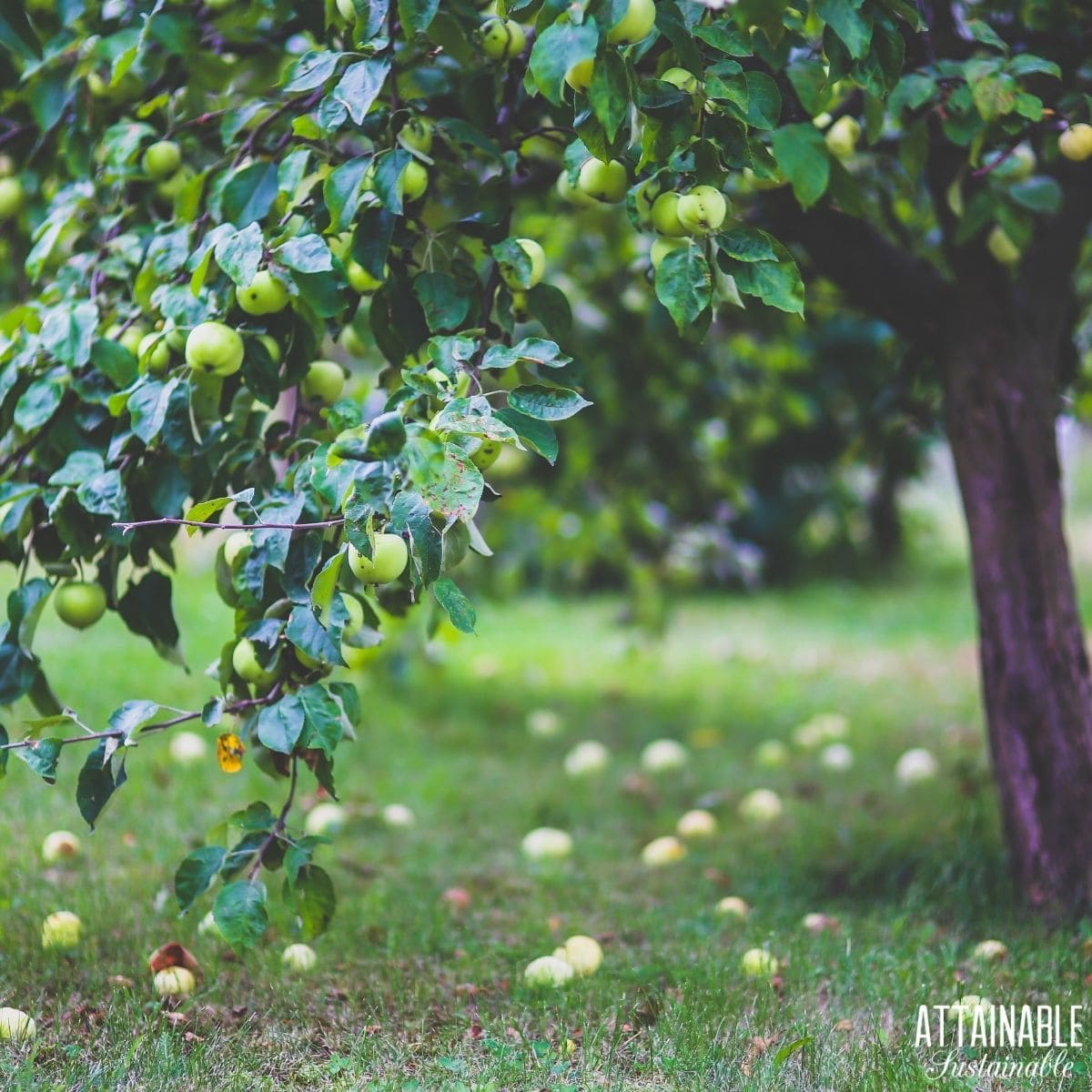
Apples that fall to the ground are good for making applesauce and apple juice.
Prevent insect pests
To protect your apples from insect pests, you’ll need to keep a lookout for the beginning of problems. Codling moths are a problem because they lay eggs that cause wormy apples. To avoid worms, spray trees every two weeks from the end of blooming until harvest.
A natural spray from chrysanthemums called pyrethrin is an organic option. Some gardeners prefer an insecticide with Carbaryl or other insecticide recommended for fruit trees. Always follow label instructions for application, and apply with a mind toward protecting bees and other beneficial insects.
As an alternative to spraying, some organic gardeners use apple maggot traps, and others staple paper bags over apples while fruits are small. The bags protect apples while they’re growing to eliminate the need for spraying.
Mites, aphids, and scale insects can be stopped by spraying with dormant oil in late winter or early spring before buds start to swell.
Prevent apple tree diseases
The best way to prevent common apple tree diseases is by selecting varieties that are resistant to these issues:
Fire blight is a bacterial problem that causes branches to blacken and leaves to appear burned. Pruning or antibiotic sprays help prevent blight.
Apple scab is a fungal disease that infects leaves and fruit. Watch for small brown circles on leaves and work to cover individual apples or spray with an organic fungicide.
Be sure to check with your county’s Cooperative Extension office for apple tree problems specific to your region.
Growing apple trees in pots
You can grow apple trees in containers if you choose the right kind of tree. Columnar apple trees are bred to grow in small spaces. Like their name, these apples grow on short branches along a tall trunk and produce full-size fruit.
The trees still need another apple tree for pollination. Look for varieties that are meant for your hardiness zone and follow any special planting instructions including the size of the container, soil requirements, and how to protect trees from cold winter weather.
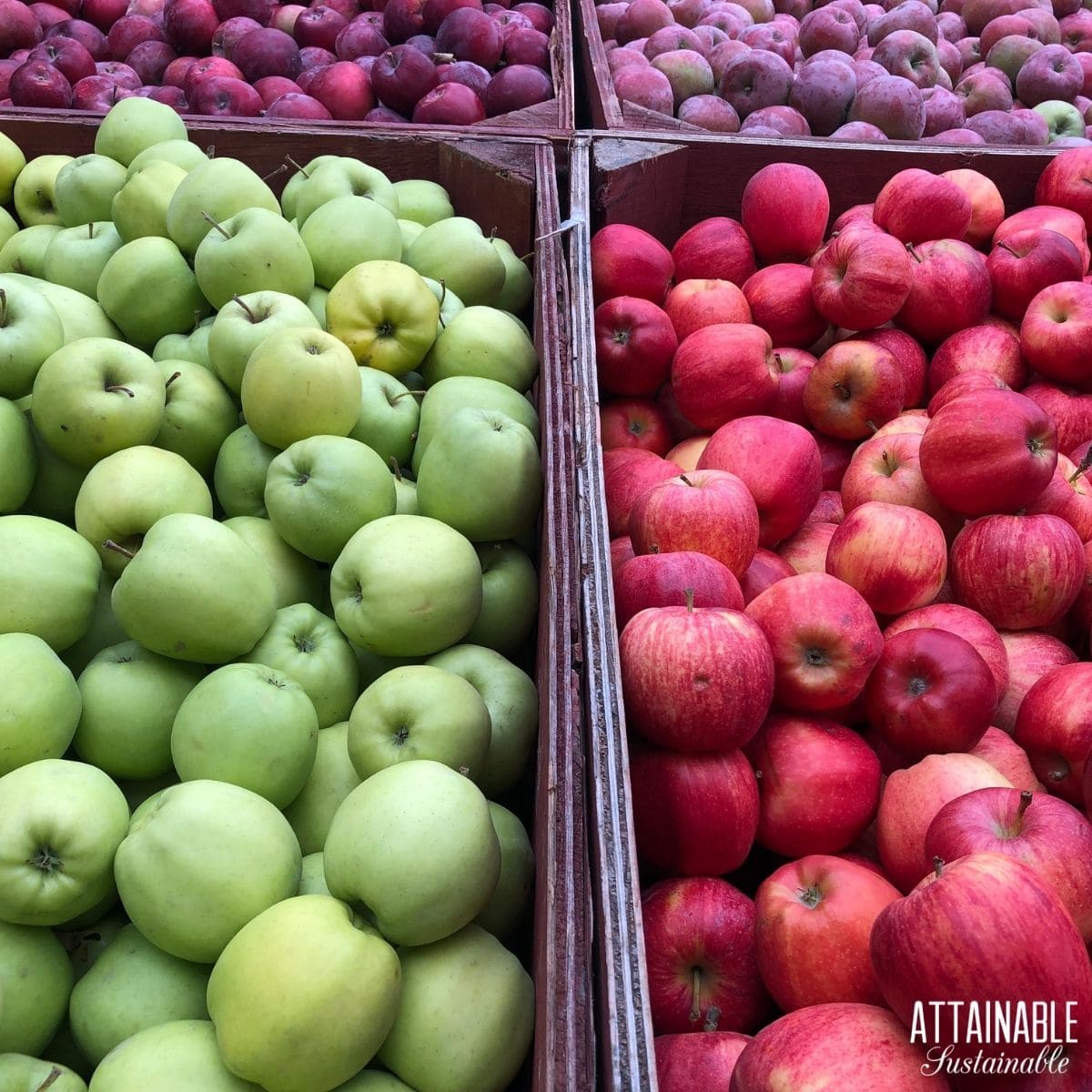
Apples come in a wide assortment of colors.
How to harvest apples
Apples are ready to pick when they’ve reached their full size, have started to change color, and pass the taste test for sweetness. You may need to pick apples over 7-14 days to ensure all the fruit is ripe enough.
Harvest apples by gently twisting and not pulling them off or harming the thick spur. Store apples in a refrigerator or a cool dark place, such as a garage or root cellar.
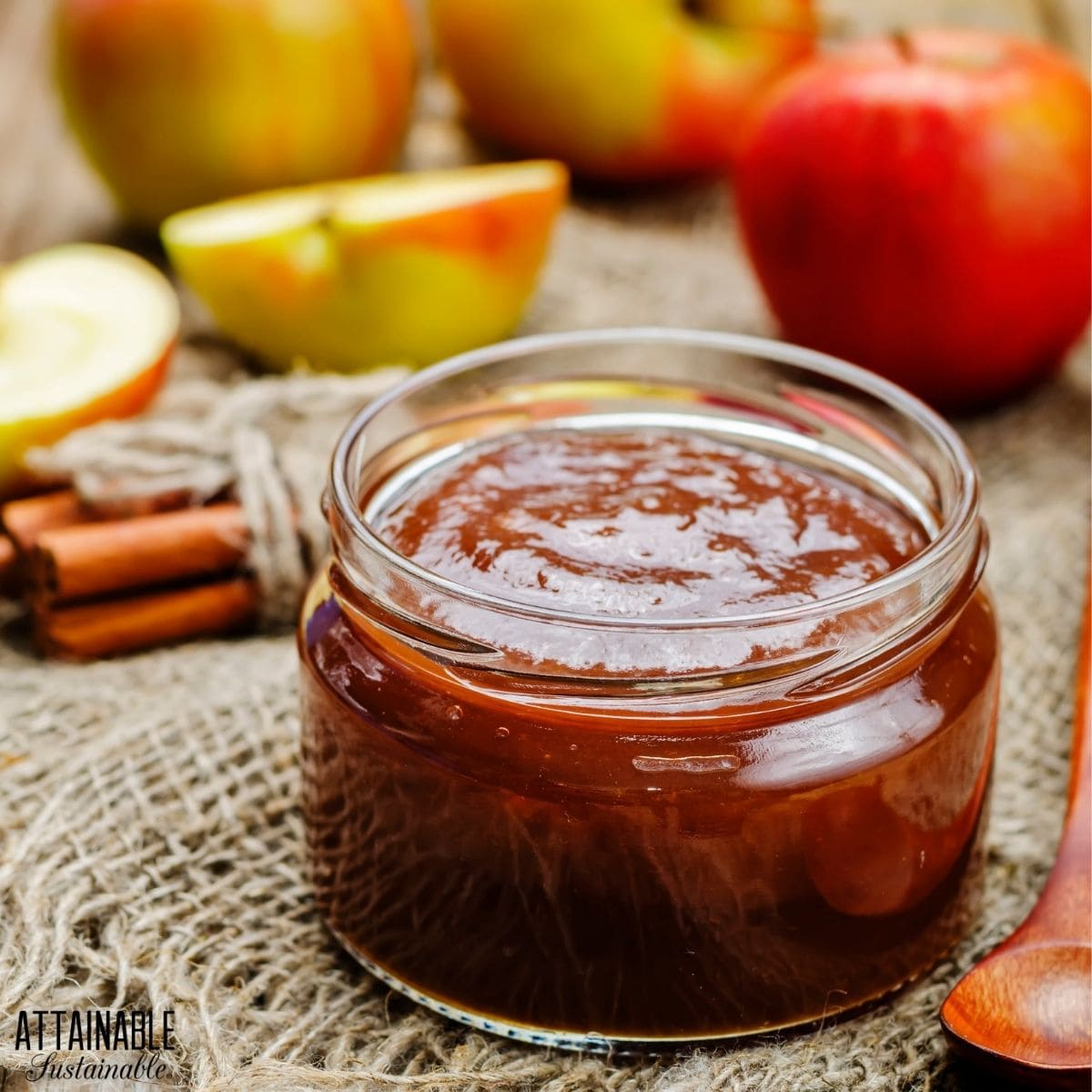
Apple butter is one of many delicious recipes to use fresh apples.
Using apples in the kitchen
Who can resist eating a crisp apple just-picked off the tree? If there are too many apples to eat like this, there are plenty of ways to enjoy them baked on their own, baked into pies, apple cobbler, French apple cake, made into applesauce, dehydrated for a snack, turned into jelly or apple butter, made into brandy or cider, and so much more.
How to propagate apple trees
Apple trees can be propagated using several methods that include grafting, budding, and layering. You can also try to start a new tree from apple seeds.
Because there’s so much involved in propagating apples, start by researching how-to instructions in books, online resources, and Extension fact sheets.
